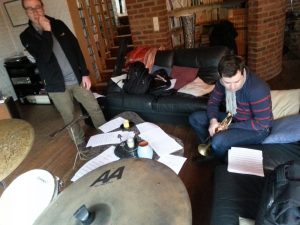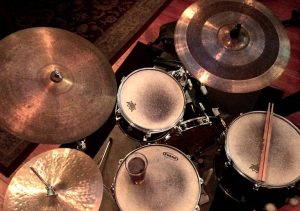 Originally posted on the CRUISE SHIP DRUMMER! blog in April 2018.
Originally posted on the CRUISE SHIP DRUMMER! blog in April 2018.
Everyone is looking for excuses to spend money on gear, so here’s a concept: rehearsal cymbals. We’ve all played rehearsals where the instrumentation and/or acoustics made it extremely difficult to play normally. Maybe there’s an unmiked vocalist, acoustic guitar, strings, whatever. A clarinetist with a really weak sound. Playing our normal 20-24″ cymbals at normal-quiet volume blows them away, so we end up playing the entire rehearsal with brushes on the snare drum and closed hihat, and it’s nothing at all like what’s going to happen on the gig. A complete waste of time.
A lot of these situations can’t be salvaged, but in general it would be nice to have cymbals that sound good when played quietly in somebody’s living room, with no audience, when we only need to project to the other players standing a few feet away.
Here is generally what I would suggest: little, thin, dry cymbals.
18″ ride — light to medium, unlathed/partially lathed, small or no bell
15″ crash — paper thin to medium thin
13″ hihats — light to medium
Some thoughts on makes and models:
Bosphorus cymbals
Their Turk series are nice cymbals, with great definition, and playing them you feel like Tony Williams on Nefertiti. They sound really nice from the playing position. I was into them for awhile, but eventually found them to be too soft for most real world playing with an audience. They don’t project well unmiked, and they don’t balance well with the rest of the drumset or with the ensemble. I’ve written about this before. But they’re good for recording, and would be good for rehearsals.
Bosphorus’s Master Series are an option that are even quieter… I have actually found many of them to be so thin and delicate they virtually have no real world application at all. But a ride that is not too thin, or a 18″ Master thin crash (check your gram weight— it should be comparable to any other brand of paper thin crash) could work very well for what we’re talking about here. Seriously, beware: there are a lot of extremely thin examples floating around that I think are completely useless as musical instruments.
Flat rides
I think I’m done with flat rides. I find them to be one dimensional and not worth the real estate in my set up. They can be good for rehearsals, though. And certain special situations. Try an 18″— or smaller, if you dare, and can find one.
Little rides
I got interested in sub-18″ rides after reading T. Bruce Wittet’s account of Connie Kay’s 17″ medium-heavy. I had a 17″ 602 and a 16″ Zildjian medium ride which were both intriguing— they really do handle like real ride cymbals, except, hey, they’re small— but for whatever reason did not hang onto them.
Paper thin crashes
I find these to mostly be too delicate for the real world, but for this usage you can get a real crash sound without generating a lot of volume and sustain.
Dixieland hihats
Usually pre-60s A. Zildjian, smaller than 14″. Revival Drum Shop, a great Portland vintage shop seems to find and carry a lot of them. They’re extremely thin, tight, and splashy, without much of a foot sound.
Sabian Sound Control
I started thinking about softer cymbals when playing a boat gig with abysmal acoustics on stage, and these Sabians were some of the first things I looked at. They’re supposed to be quieter than normal cymbals. I never found one to purchase before I got into Bosphorus cymbals, and the few I encountered never struck me as particularly quiet. But I have found many newer Sabian AAs and AAXs to have a minor case of Bosphorusitis— their sound has been so refined that they lose some body… which makes them good for this purpose. A 20″ Raw Ride (18″ if you can find one) would be good, or a small El Sabor crash. I have used an older Jack Dejohnette Signature Ride before, but the combination of being extremely dry with a very penetrating stick sound made them unattractive for this purpose.
Tape
Often the problem in these situations is the signal to noise ratio: when playing very soft, and in close quarters, the wash of the cymbal is amplified relative to the attack of the note. You can cut down on the wash by applying 1-4 pieces of masking tape on the underside of the cymbal, radiating out from the bell. It’s not a very popular solution any more, and not as fun as buying more cymbals. Less is more, if you choose to do this.
What do I use for rehearsals?
13″ Bosphorus Turk Hihats — Their normal light model. I’ve used mine on every recording I’ve made in the last 15 years. I now find them too insubstantial for normal performance applications.
17″ Cymbal & Gong Holy Grail Crash — A great cymbal I now never go anywhere without. Thin, rather dead (in a good way!), with great crash, ride, and bell sounds. I could do the whole rehearsal just on this cymbal.
18″ Cymbal & Gong Holy Grail Ride — With three rivets. An unassuming medium-weight cymbal that happens to sound great with other musicians. Very traditional bebop sound.
Here is my 18″ Holy Grail ride, together with my 18″ Leon Collection crash, and 14″ Holy Grail Hihats:

 Originally posted on the CRUISE SHIP DRUMMER! blog in
Originally posted on the CRUISE SHIP DRUMMER! blog in